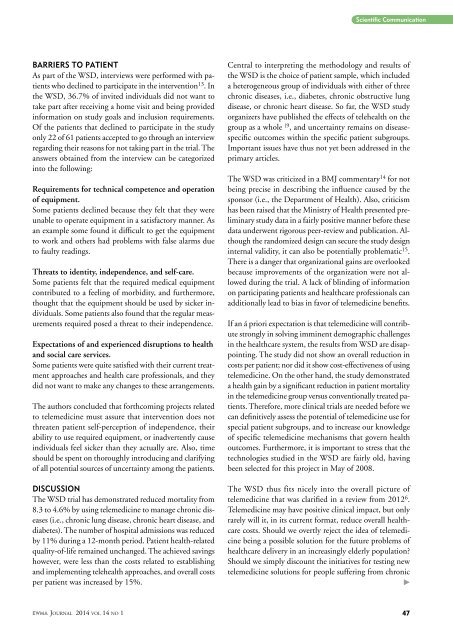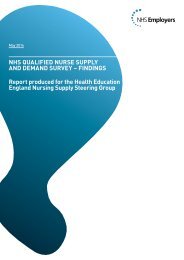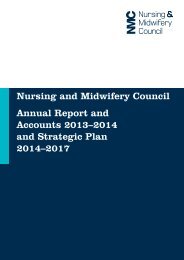Journal_1_2014_final_WEB
Journal_1_2014_final_WEB
Journal_1_2014_final_WEB
You also want an ePaper? Increase the reach of your titles
YUMPU automatically turns print PDFs into web optimized ePapers that Google loves.
Scientific Communication<br />
Barriers to patient<br />
As part of the WSD, interviews were performed with patients<br />
who declined to participate in the intervention 13 . In<br />
the WSD, 36.7% of invited individuals did not want to<br />
take part after receiving a home visit and being provided<br />
information on study goals and inclusion requirements.<br />
Of the patients that declined to participate in the study<br />
only 22 of 61 patients accepted to go through an interview<br />
regarding their reasons for not taking part in the trial. The<br />
answers obtained from the interview can be categorized<br />
into the following:<br />
Requirements for technical competence and operation<br />
of equipment.<br />
Some patients declined because they felt that they were<br />
unable to operate equipment in a satisfactory manner. As<br />
an example some found it difficult to get the equipment<br />
to work and others had problems with false alarms due<br />
to faulty readings.<br />
Threats to identity, independence, and self-care.<br />
Some patients felt that the required medical equipment<br />
contributed to a feeling of morbidity, and furthermore,<br />
thought that the equipment should be used by sicker individuals.<br />
Some patients also found that the regular measurements<br />
required posed a threat to their independence.<br />
Expectations of and experienced disruptions to health<br />
and social care services.<br />
Some patients were quite satisfied with their current treatment<br />
approaches and health care professionals, and they<br />
did not want to make any changes to these arrangements.<br />
The authors concluded that forthcoming projects related<br />
to telemedicine must assure that intervention does not<br />
threaten patient self-perception of independence, their<br />
ability to use required equipment, or inadvertently cause<br />
individuals feel sicker than they actually are. Also, time<br />
should be spent on thoroughly introducing and clarifying<br />
of all potential sources of uncertainty among the patients.<br />
DISCUSSION<br />
The WSD trial has demonstrated reduced mortality from<br />
8.3 to 4.6% by using telemedicine to manage chronic diseases<br />
(i.e., chronic lung disease, chronic heart disease, and<br />
diabetes). The number of hospital admissions was reduced<br />
by 11% during a 12-month period. Patient health-related<br />
quality-of-life remained unchanged. The achieved savings<br />
however, were less than the costs related to establishing<br />
and implementing telehealth approaches, and overall costs<br />
per patient was increased by 15%.<br />
Central to interpreting the methodology and results of<br />
the WSD is the choice of patient sample, which included<br />
a heterogeneous group of individuals with either of three<br />
chronic diseases, i.e., diabetes, chronic obstructive lung<br />
disease, or chronic heart disease. So far, the WSD study<br />
organizers have published the effects of telehealth on the<br />
group as a whole (9 , and uncertainty remains on diseasespecific<br />
outcomes within the specific patient subgroups.<br />
Important issues have thus not yet been addressed in the<br />
primary articles.<br />
The WSD was criticized in a BMJ commentary 14 for not<br />
being precise in describing the influence caused by the<br />
sponsor (i.e., the Department of Health). Also, criticism<br />
has been raised that the Ministry of Health presented preliminary<br />
study data in a fairly positive manner before these<br />
data underwent rigorous peer-review and publication. Although<br />
the randomized design can secure the study design<br />
internal validity, it can also be potentially problematic 15 .<br />
There is a danger that organizational gains are overlooked<br />
because improvements of the organization were not allowed<br />
during the trial. A lack of blinding of information<br />
on participating patients and healthcare professionals can<br />
additionally lead to bias in favor of telemedicine benefits.<br />
If an á priori expectation is that telemedicine will contribute<br />
strongly in solving imminent demographic challenges<br />
in the healthcare system, the results from WSD are disappointing.<br />
The study did not show an overall reduction in<br />
costs per patient; nor did it show cost-effectiveness of using<br />
telemedicine. On the other hand, the study demonstrated<br />
a health gain by a significant reduction in patient mortality<br />
in the telemedicine group versus conventionally treated patients.<br />
Therefore, more clinical trials are needed before we<br />
can definitively assess the potential of telemedicine use for<br />
special patient subgroups, and to increase our knowledge<br />
of specific telemedicine mechanisms that govern health<br />
outcomes. Furthermore, it is important to stress that the<br />
technologies studied in the WSD are fairly old, having<br />
been selected for this project in May of 2008.<br />
The WSD thus fits nicely into the overall picture of<br />
telemedicine that was clarified in a review from 2012 6 .<br />
Telemedicine may have positive clinical impact, but only<br />
rarely will it, in its current format, reduce overall healthcare<br />
costs. Should we overtly reject the idea of telemedicine<br />
being a possible solution for the future problems of<br />
healthcare delivery in an increasingly elderly population?<br />
Should we simply discount the initiatives for testing new<br />
telemedicine solutions for people suffering from chronic<br />
<br />
EWMA <strong>Journal</strong> <strong>2014</strong> vol 14 no 1 47




